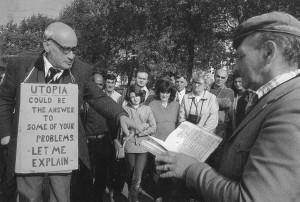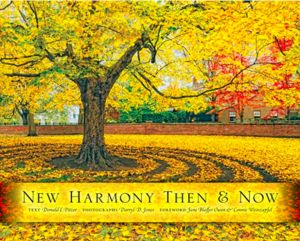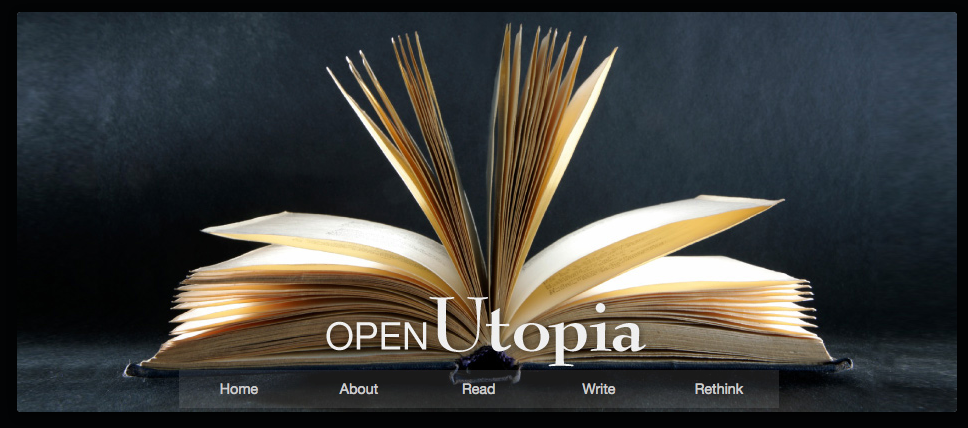“I thought readers of Utopus Discovered might be interested in a new podcast I’ve started called Utopian Horizons. The idea is that it will cover a different utopia, dystopia, utopian thinker, or movement in each episode.
Category Archives: Miscellaneotopia
Have Your Utopia—And Eat it Too
Has anyone seen the Attunefoods brand of cereal called “Erewhon”? It’s in pretty much every grocery store in Northeast Ohio. According to their website:
“Since 1966, Erewhon has led the organic revolution and we remain passionately committed to providing the purest organic foods. We continue promoting the philosophy that ‘if what you eat is good, and pure, and true to its source, all else will follow.’ It’s the cereal you can feel good about eating whether you’re enjoying our Organic Whole Wheat Raisin Bran, Organic Rice cereals, Organic Corn cereals or Organic Buckwheat cereal. Our Erewhon organic cereals are made of non-GMO ingredients and feature nine certified gluten-free flavors.”
This blurb, of course, makes no mention of its namesake, Erewhon: or, Over the Range, by Samuel Butler, nor of its relation to utopia, but I do wonder if we can assume that the company’s commitment to “providing the purest organic foods” is a manifestation of the utopian imagination.
What do you think?
Check out the cereal here: http://www.attunefoods.com/products/Erewhon-Gluten-Free
Utopia Could Be the Answer
From Ken Roemer: “Via snail mail Mickey Abrash, one of the two founders (along with Art Lewis) of SUS, sent me this photo he found in his file. The photo was taken in the “Speaker’s Corner” in London. MIckey said it was sent to him in 1984. He doesn’t know who the sign holder was. Maybe someone in cyberland can identify him.”
It would be interesting indeed to see if anyone out there knows who this is. Either way, it is an interesting photo. Enjoy.
—ed.
New Harmony Then and Now
About a week ago, I received a book in the mail from Indiana University Press called New Harmony Then and Now, that the press describes as follows: “New Harmony Then and Now is a photographic and historic celebration of two of America’s great Utopian communities located in New Harmony, Indiana. The Harmonists, started by George Rapp, labored to provide physical, intellectual, and spiritual wealth for its members. Ten years later, the Owenites, founded by Robert Owen and his partner William Maclure, settled there, intent on improving humanity through innovations in social theory, educational systems, and discoveries in natural science. Though Owen’s communal experiment would not endure, a new social frontier prospered. Today, New Harmony remains a haven of promise, a village that honors its progressive heart. Intellectuals as well as artisans are drawn to this place of science and spirit.”
This is a beautiful book with beautiful pictures, and I recommend you check it out. —AH
“Utopia, Dystopia, Heterotopias: From Luxun to Liu Cixin.”
Guangyi Li says:
“For those who feel interested in Chinese utopia and science fiction, here is an important speech by David Der-wei Wang, ‘Utopia, Dystopia, Heterotopias: From Luxun to Liu Cixin.’”
Check it out here.
The Open Utopia
“. . . though no one owns anything, everyone is rich.” —Thomas More
You may have seen the fliers for The Open Utopia on the tables at the Welcome Reception at this year’s SUS annual meeting, but if you haven’t yet visited the site, here’s what it’s all about: Stephen Duncombe has created an open version of Thomas More’s Utopia, “open to read, open to copying, open to modification.” The latter refers specifically to “an annotatable and ‘social’ text available for visitors to comment upon what More – or [Duncombe] – have written, and then share their comments with others.” There are even audio versions of Utopia, “user-generated galleries of Utopia-themed art and videos,” and “[f]or people interested in creating their own plan of an alternative society, . . . a wiki with which to collaborate with others in drafting a new Utopia.” Additionally, “all the letters and commendations, as well as the marginal notes, that were included in the first four printings of [Utopia in] 1516-1518 in which More himself had a hand” are included.
Duncombe has clearly put a lot of work into this project, and it’s definitely worth checking out. Do so at http://theopenutopia.org/home/.
The Meaning of Utopia in NY Times
Yves Charles Zarka was published in the Opinion section of the NY Times yesterday, and Peter Sands sent a link out to the H-Net Utopia ListServ. Are you on H-Net? Maybe you should be. Anyway, Zarka’s opinion piece is worth the read, and it’s available here: http://opinionator.blogs.nytimes.com/2011/08/28/the-meaning-of-utopia/?ref=opinion&nl=opinion&emc=tya1.
Building Expectation: Past and Present Visions of the Architectural Future
The David Winton Bell Gallery will present Building Expectation: Past
and Present Visions of the Architectural Future from September 3
through November 6. An opening reception and lecture by the exhibition
curator Nathaniel Walker will be held on Friday, September 9, from
5:30–7:30 p.m.
It has been said that the past is a foreign country—but it is the
future that remains undiscovered. Despite the obvious truth that no
one has been to the future, that no one has even seen a photograph of
it, the last two centuries have witnessed the rise of a body of visual
codes and tropes that are commonly seen and understood as
“futuristic.” These “progressive” or “modern” attributes are derived
from an entirely imaginary landscape, indicative of a destination that
is impossible to visit; yet nearly everyone can recognize the place
where no one has been.
Building Expectation: Past and Present Visions of the Architectural
Future offers a glimpse into this undiscovered country, presenting a
collection of historic and ongoing visions of the future from the
nineteenth century until the present day. The focus of the show is
less upon canonical designers or art-historical movements and more
upon broadly based, popular speculation in the public sphere. The
exhibition’s content has been drawn from a number of university
libraries and private collections, as well as the Swiss
state-supported museum of utopia known as the Maison d’Ailleurs (House
of Elsewhere). Many of these objects have never before been exhibited
in the United States.
The “world of tomorrow” has usually been imagined first and foremost
as a place—the new Promised Land, the millennial landscape. And
architecture, cast since the Enlightenment as the calling card for
cultural and technological periods in the “grand narrative” of human
development and progress, has always been one of the future’s most
revealing and recognizable features. The exhibition’s collection of
past architectural visions has been divided into three categories,
each highlighting a different motive or guiding principle in the
crafting of future worlds. First are imaginary places designed to
articulate and support political reform schemes, such as Robert Owen’s
early-Victorian industrial paradise of New Harmony, brought to life in
the highly detailed drawings he published to advocate a new world
order framed by garden-filled Gothic factories-for-living. The second
group of futuristic visions consists of exotic locales crafted to make
money on the open market by functioning as amusing and/or inspiring
distractions, such as the sparkling, whirring glass cities which fill
early-twentieth century pulp magazines and utopian romance novels.
The final category of past visions is made up of futuristic cityscapes
constructed to lend the prestige and promise of “the future” to
personalities, products, and corporations by cleverly (and often
beautifully) drawn lines of association, such as Syd Mead’s 1969
“Portfolio of Probabilities” commissioned by United States Steel.
Considered together, the many futuristic codes created and deployed in
these different categories of vision are revealed not as truly
“forward-looking” glimpses of tomorrow, but rather as artifacts of the
past that have been aesthetically formed and have acquired meaning in
historical processes of their own.
The final portion of the exhibition is dedicated to contemporary
visions of the future, chosen or commissioned for their makers’
ability to continue the critical conversation about the “world of
tomorrow.” A number of the participants offer futuristic design
paradigms that openly defy some of the most persistent dogmas of
progressive Modernism, while others take the conceptual processes of
technological evolution to their furthest extremes. All of them call
into question those aspects of “the future” that have been, and often
still are, taken for granted. Artists such as Pippi Zornoza, Jane
Masters, and Brian Knep, all based in New England, have created large
installations that are architectural in their scope as well as their
content. Others such as Swiss artist Christian Waldvogel and the
urban design firm DPZ are showing works resulting from years of study
and refinement in sites around the world.
Spanning the gap between past visions and contemporary concepts of the
future is a new drawing by illustrator Katherine Roy. It depicts the
wonderful but deeply troubled city of “Industria,” a radiant urban
landscape described in the largely forgotten 1884 novel Ignis by Comte
Didier de Chousy. A fevered, delirious paradise, it is the stage for a
satirical tragic comedy of utopian proportions, and Roy’s illustration
speaks on multiple levels to the past and ongoing cultural processes
that may be said to “build expectation.”
Googling Utopia
Back in October I thought it might be interesting for Miscellaneotopia if I were to simply Google the word “utopia” and report my findings. On the first page of search results alone, I turned up the Wikipedia page on Utopia, an online role-playing game called Utopia that has apparently been around since 1998 (plus two additional sites that offer tools for maximizing play!), a sixteen-city fiber-optic network in Utah called Utopia, a salon in Cuyahoga Falls, Ohio called Utopia (this one comes up, no doubt, because I live one city over from Cuyahoga Falls), a line of eyewear (goggles and the like) for surfers and motocross riders, an Ohio-based motorcycle upholstery business specializing in a custom seat design called “The Utopia,” a website called Utopia: Asian Gay & Lesbian Resources, the Dictionary.com definition of utopia, and the text of Thomas More’s Utopia hosted on an instructor webpage at Oregon State University. I’m not sure what I was expecting to come up having performed such a search, but the results were, well, diverse—to say the least. It might be interesting for other Utopus Discovered readers to Google utopia and report their first-page findings too. Takers?
əkoostik hookah’s “Utopia”
I recently discovered that the Ohio-based jamband əkoostik hookah has a song called “Utopia” that appeared on its first album, Under Full Sail (1991). Although the band has been around at least since ‘91, they haven’t done much outside the Ohio regional music scene. Nevertheless, Under Full Sail was revisited by the jam-rock band, whose original singer, John Mullins, rejoined the band after a long absence in 2007 (but left again in 2010). At that time, the band entered the studio and rerecorded songs from the original Under Full Sail record, then performed a live concert in the studio space for its most die-hard fans. Among the tracks on the resulting release (entitled Under Full Sail: It All Comes Together), is the song, “Utopia.” In spite of these developments, a quick internet search will not help to find lyrics to the song, but some enterprising utopia scholar interested in music may take up the task (hint hint). There is also a rather impressive YouTube video of the band performing the song live in 2004 available here.



